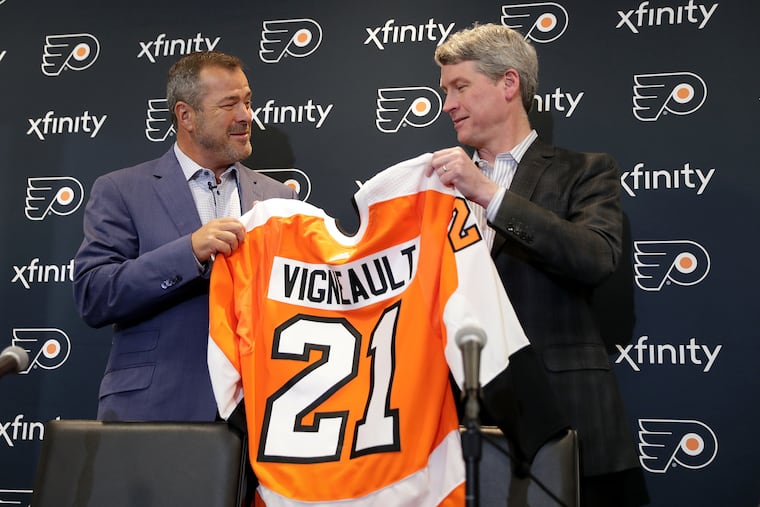Chuck Fletcher’s first year as Flyers GM: The good, the bad, the best | Sam Carchidi
Fletcher has done a lot of good things that have made the team significantly better.

ST. PAUL, Minn. — A little more than a year ago, shortly after Ron Hextall’s stunning firing, Chuck Fletcher was named as the eighth different general manager in the Flyers’ history.
Are the Flyers better off now?
Well, yes.
Part of it is because of the farm system and cap situation Hextall left Fletcher.
Part of it is because of moves made by Fletcher.
Here’s a look at some of Fletcher’s key moves over the last year and how they have shaped the Flyers:
Coaches’ shuffle
The best move Fletcher has made in his first year was hiring Alain Vigneault as head coach. Vigneault has brought a calming but authoritative presence to the organization, and he holds all players accountable.
Whether they are making the minimum salary or $8.2 million per season, Vigneault treats them all the same and isn’t afraid to give them less playing time if they aren’t producing.
Former Flyers coach Dave Hakstol was a good man trying to make the gargantuan jump from the college ranks to the NHL, but he didn’t get the respect of his players that Vigneault gets because of his impressive resume and the way he commands a room.
Hextall, for all his many strengths, didn’t see that Hakstol wasn’t getting through to his players. The team rarely played a full 60 minutes under Hakstol and its starts to games were repeatedly head-shaking.
The Flyers’ upper management dropped hints that it thought Hakstol wasn’t the answer. Hextall didn’t listen. Fletcher fired the coach.
Trade grade
In his best deal to date, Fletcher deserves a B-plus for bringing in Matt Niskanen for Radko Gudas. The grade would be higher, but he agreed to pay 30% of Gudas’ contract.
Fletcher, who spent nine mostly successful seasons as Minnesota’s general manager, said in the offseason that his No. 1 goal was to improve the defense, and he’s done just that. The Flyers aren’t making quite the turnaround as the Islanders did last season — going from worst to first in goals allowed — but their improvement has been eye-opening.
The Flyers entered the weekend seventh in the NHL in goals allowed per game (2.68), a massive climb from finishing 29th last season (3.41).
The Niskanen trade is a big reason. He has stabilized the back end and brought out the best in his defensive partner, Ivan Provorov. Niskanen has also upgraded the much-improved penalty kill. So has free agent Kevin Hayes, though you could argue having Carter Hart from the start of the season has been the biggest reason the PK has gone from 26th (78.5% success rate) to fourth (85.1% success rate) in the NHL.
Raiding Phantoms
One of the biggest differences between Fletcher and Hextall?
Fletcher’s trust in young players. He has had six Phantoms make their NHL debuts in the first two-plus months. Would players such as Joel Farabee (19 years old)) and Morgan Frost (20) be with the Flyers under Hextall? Perhaps. He did, after all, bring Travis Konecny and Provorov to the Flyers when they were 19.
But based on his track record, he probably would have relied on veterans (see Dale Weise, Jori Lehtera, and Chris VandeVelde) instead of taking chances on other young players such as Carsen Twarynski, Connor Bunnaman, Misha Vorobyev, David Kase, and German Rubtsov.
Draft results
This was a Hextall strength. Look at the current roster (when it is healthy), and it is filled with key players Hextall drafted, including Hart, Oskar Lindblom (a fifth-round steal in 2014), Konecny, Provorov, Travis Sanheim, Farabee, Frost, and Nolan Patrick.
Fletcher’s one draft with the Flyers looks highly productive, especially in the first two rounds.
Some fans were irate that he bypassed Cole Caufield, a diminutive right winger regarded as the best pure scorer in the 2019 draft, and instead chose defenseman Cam York in the first round. But he also acquired a second-round pick that enabled him to select high-scoring right winger Bobby Brink in the second round.
Getting a potential first-pairing defenseman and someone who should be an NHL sniper some day seems to make more sense. The move will be determined down the road, when we find out if Caufield, now starring at the University of Wisconsin, is better than the two players Fletcher selected.
Cap situation
Hextall did an amazing job getting the Flyers out of cap problems he had inherited from his predecessor, Paul Holmgren. Heck, Hextall was even able to trade Chris Pronger’s contract to Arizona long after he had retired because of a concussion.
Fletcher has the Flyers again up against the cap. Acquiring Justin Braun ($3.8 million cap hit) and paying some of Gudas’ salary didn’t help. Some argue he overpaid for Hayes ($7.1 million cap hit), but when you consider Fletcher knew at the time that Patrick was having migraine problems and might not be available for a while, it puts the signing in better perspective. Fletcher desperately needed to add a productive center.
Bottom line
When Fletcher took over the Flyers last December, they were seventh in the eight-team Metropolitan standings and near the bottom of the NHL. Flip the calendar a year ahead. They are sixth in points percentage (.629) among the 31 NHL teams this season.
In other words, he has made significant strides in just one year and hasn’t broken up the farm system or traded away major pieces to get there. That’s not easy to do.
The next step — which might require a signature trade at some point — is putting the Flyers in a position to challenge seriously for the Stanley Cup.